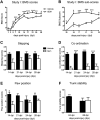The PPAR alpha agonist gemfibrozil is an ineffective treatment for spinal cord injured mice
- PMID: 21963672
- PMCID: PMC5518476
- DOI: 10.1016/j.expneurol.2011.09.023
The PPAR alpha agonist gemfibrozil is an ineffective treatment for spinal cord injured mice
Abstract
Peroxisome Proliferator Activated Receptor (PPAR)-α is a key regulator of lipid metabolism and recent studies reveal it also regulates inflammation in several different disease models. Gemfibrozil, an agonist of PPAR-α, is a FDA approved drug for hyperlipidemia and has been shown to inhibit clinical signs in a rodent model of multiple sclerosis. Since many studies have shown improved outcome from spinal cord injury (SCI) by anti-inflammatory and neuroprotective agents, we tested the efficacy of oral gemfibrozil given before or after SCI for promoting tissue preservation and behavioral recovery after spinal contusion injury in mice. Unfortunately, the results were contrary to our hypothesis; in our first attempt, gemfibrozil treatment exacerbated locomotor deficits and increased tissue pathology after SCI. In subsequent experiments, the behavioral effects were not replicated but histological outcomes again were worse. We also tested the efficacy of a different PPAR-α agonist, fenofibrate, which also modulates immune responses and is beneficial in several neurodegenerative disease models. Fenofibrate treatment did not improve recovery, although there was a slight trend for a modest increase in histological tissue sparing. Based on our results, we conclude that PPAR-α agonists yield either no effect or worsen recovery from spinal cord injury, at least at the doses and the time points of drug delivery tested here. Further, patients sustaining spinal cord injury while taking gemfibrozil might be prone to exacerbated tissue damage.
Copyright © 2011 Elsevier Inc. All rights reserved.
Figures







References
-
- Basso DM, Fisher LC, Anderson AJ, Jakeman LB, McTigue DM, Popovich PG. Basso Mouse Scale for locomotion detects differences in recovery after spinal cord injury in five common mouse strains. J. Neurotrauma. 2006;23:635–659. - PubMed
-
- Besson VC, Chen XR, Plotkine M, Marchand-Verrecchia C. Fenofibrate, a peroxisome proliferator-activated receptor alpha agonist, exerts neuroprotective effects in traumatic brain injury. Neurosci Lett. 2005;388:7–12. - PubMed
-
- Bordet R, Ouk T, Petrault O, Gele P, Gautier S, Laprais M, Deplanque D, Duriez P, Staels B, Fruchart JC, Bastide M. PPAR: a new pharmacological target for neuroprotection in stroke and neurodegenerative diseases. Biochem. Soc. Trans. 2006;34:1341–1346. - PubMed
-
- Brunmair B, Lest A, Staniek K, Gras F, Scharf N, Roden M, Nohl H, Waldhausl W, Furnsinn C. Fenofibrate impairs rat mitochondrial function by inhibition of respiratory complex I. J Pharmacol Exp Ther. 2004;311:109–114. - PubMed
Publication types
MeSH terms
Substances
Grants and funding
LinkOut - more resources
Full Text Sources
Medical

